Caribbean Stud (CS) is not a common game in U.S. casinos, but worldwide it continues to have a strong presence. CS has a well-known vulnerability to player collusion, where a full table of seven players can get a practical edge of about 1.4% over the house. Another way AP teams have beaten CS is by edge sorting, which gives a much stronger edge of about 6.9% (see this post). Apparently, this is not the end of the story. A few weeks back I read this post:
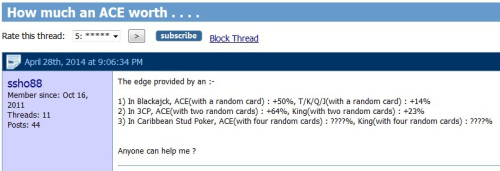
It is apparent from (1) and (2) that the poster, ssho88, has made top card plays against both blackjack and Three Card Poker. In other words, ssho88 has used a method that gives information about the first card dealt in a round. If it is not burned, this card is dealt to the player at first base. Top card information allows the AP to make a large bet when he has the edge; otherwise he makes a small wager or sits out the hand. The question that ssho88 asks indicates top card play against CS.
To understand how top card play against CS can take place, imagine looking down into an iDeal shuffler while sitting at first base. The AP may see the following, allowing him to inspect the top card:
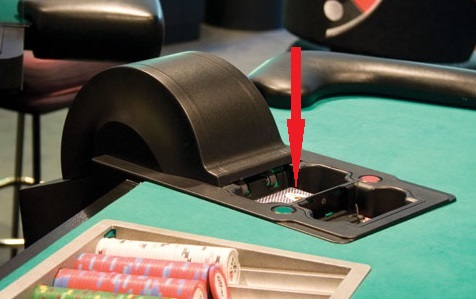
Likewise, the AP may be able to inspect the top card of the packet of cards waiting to be dealt to first base sitting in an Ace shuffler:
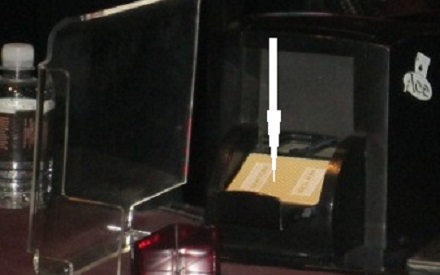
When used correctly, the first packet for the next round is not ejected until the cards from the previous round are placed into the feeder for the shuffler. By waiting for all wagers to be placed before feeding in the cards, the game is protected from top card play. However, to speed up the game, many casinos immediately feed in the cards from the previous round before players complete their wagers for the next round. A packet of five cards may be ejected and sit in the tray waiting to be dealt to the player at first base. The player at first base can carefully inspect the top card of the packet he will be dealt before making his wager. Any flaw in the top card gives information. Note that if the shuffler is located at third base, then a teammate at third base can signal his first-base partner.
In the case of CS, ssho88 is asking what edge he will get if he knows the top card is a King (so that his cards are K????) or an Ace (so that his cards are A????). This is not the same as asking about the edge if the hand contains a King (or Ace). It specifically addresses the question of the edge when the top card of the packet of five cards is a King (or Ace). This question makes perfect sense if ssho88 is edge sorting CS into the usual {A,K} grouping.
Questions (1) and (2) asked by ssho88 indicate a history of edge sorting blackjack and Three Card Poker. Speculation gives a number of possibilities here. Perhaps ssho88 can inspect the top card as it rests in the shuffler. Maybe the casino’s dealing procedure does not expose the backs of the dealer’s cards so that reading the sort for the dealer’s hand is ruled out. Maybe the cards are high quality so that it takes a considerable effort to read the cards. In this situation, it may be the case that only the top card in the shuffler can be distinguished. Whatever the method, it is clear that ssho88 has a specific top card opportunity in mind.
As a reminder, the baseline house edge for CS is 5.224306%. In the spirit of publishing something original about the house edge, the following Excel spreadsheet gives the expected value for each of the 134459 equivalence classes of five-card starting hands for the player. It also gives the number of suit-permutations for each hand. These values are then used to compute the house edge.
To continue, assume the player knows the exact rank of the top card of the five-card hand he will be dealt. The following table gives the house edge by top card:
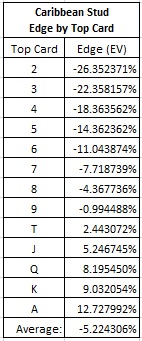
Computing the values in the table above was exhausting for my poor computer. Each row consisted of evaluating 1,916,656,780,500 (1.9 trillion) unique hands. By running concurrent threads, the full computation took just over 10 hours. At the end of the computation, my computer pleaded with me for some Higgs-Boson-flavored Gatorade. Naturally, I declined the request, preventing a Higgs-collapse of the multiverse into a singularity. Damn computers!
To answer the questions posed by ssh088:
- If a King is the top card of the five-card hand the AP will be dealt, so that the AP’s hand is K????, then the AP’s edge over the house is about 9.032%.
- If an Ace is the top card of the five-card hand the AP will be dealt, so that the AP’s hand is A????, then the AP’s edge over the house is about 12.728%.
- If either an Ace or King is the top card of the five-card hand the AP will be dealt, so that the AP’s hand is either K???? or A???? but he can't distinguish which, then the AP’s edge over the house is about 10.880%. This occurs with the standard {A,K} edge sort for CS.
Note that the AP has the edge whenever the top card of the packet he will be dealt is a Ten, Jack, Queen, King or Ace. As the table above indicates, if an AP wants to use top card play alone, then the optimal sort is into the following two groups:
- Group #1 = {2, 3, 4, 5, 6, 7, 8, 9}.
- Group #2 = {T, J, Q, K, A}.
The AP has the edge whenever the top card of his five-card hand is from Group #2. The house has the edge whenever the top card of the AP's five-card hand is from Group #1.
The following table gives statistics for the AP if he only plays when the top card is from Group #2 and otherwise does not make a wager:
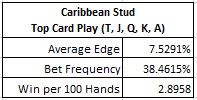
This table shows that by top carding the AP will have an average edge of about 7.5% on about 38.5% of his hands. By comparison, edge sorting the dealer’s hand gives a 6.9% edge on 100% of the hands, a much stronger play. Clearly, the AP would prefer to edge sort the dealer’s hand. Just because a method is desired does not mean it is available; the AP will take what he can get.
The following procedures can be used to protect CS from top carding:
- Include a “turn” before the deck is placed into the shuffler.
- Do not feed the deck into the shuffler until all players have placed their wagers for the next round. Alternatively, a cut card can be placed on top of the first packet of cards after it is ejected from the shuffler so that the top of this card is not visible.
- Watch for a player at first base who has a large spread in his bets.
- Watch for team play to sort the cards and keep them sorted.
- Watch for signaling if the shuffler is located at third base.


